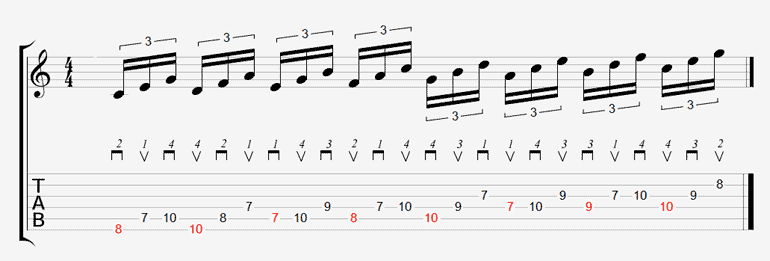Exercise 1: major scale in triads
This exercise, ‘major scale in triads’, is one of my favourite exercises for a few different reasons. For the left hand, it is a great warm up for every finger as it incorporates a number of different finger patterns/sequences (2-1-4, 4-2-1, 1-4-3, 4-3-1, etc.) If played with strict alternate picking (recommended at first), for the right hand there are elements of both inside and outside picking, making it a killer picking exercise. Finally, unlike some warmup exercises that are a great workout for your hands but make no musical sense, this one is based on the major scale and can be played over any song or backing track in a major key. An understanding of where the notes come from will benefit your theory. You will find patterns from this exercise creeping into your lead and rhythm playing in the form of arpeggiated solo lines and alternative chord (triad) voicings and inversions.

Playing the exercise
As far as the exercise goes, it is fairly straight forward. Start slowly make sure you are fretting each note cleanly before building up speed. I would recommend playing with a metronome. I have written the notes as triplets, however it may be easier to think of these as straight sixteenth or eighth notes and play them with each metronome stroke. Focus on strict alternate picking, ensuring you don’t break the down-up-down-up sequence. I have marked the picking direction on the tab above. Once you are comfortable starting with a downstroke, try the exercise starting with an upstroke.
For the fretting hand, begin the exercise with your middle finger. There are some tricky fingerings, such as the consecutive pinky-pinky across strings. For these you can either barre both strings with your pinky or roll your pinky after you have played the first of these notes. Either way, focus on keeping the rhythm consistent.
The theory behind the exercise
The notes in this exercise are all notes from the major scale. You can play the exercise in any key, however, for simplicity of the analysis, it is written here in the key of C. The notes highlighted in red represent the ascending C major scale – C D E F G A B C.
Instead of simply going up the scale one note at a time, this exercise ascends in triads – 1,3,5; 2,4,6; 3,5,7; and so-on, where the numbers represent the degrees of the scale. These triads form the seven distinct diatonic chords of the C major scale, finally ending back with C major:
| Triad 1 | Triad 2 | Triad 3 | Triad 4 | Triad 5 | Triad 6 | Triad 7 | Triad 8 | |
| Notes | C E G | D F A | E G B | F A C | G B D | A C E | B D F | C E G |
| Chord | C major | D minor | E minor | F major | G major | A minor | B dim | C major |
As you can see from the table above, every note from this exercise comes from C major scale. Hopefully in practicing this exercise, with its unusual fingerings and picking patterns, you will start to develop your own licks that can be used to build riffs and solos based on the major scale.
While the description above focuses on the key of C major, the same applies regardless of where you start the exercise on the neck, simply transpose the table by the correct number of half-steps to suit whichever key you are playing in.
To extend this exercise further, try playing up into the second octave, using the higher strings on the guitar. You can also try playing the pattern in descending fashion, either starting with the high C E G, then B D F, coming down sequentially (with each triad still played as an ascending triad), or with each triad played in reverse, starting with high G E C, followed by F D B, etc.
